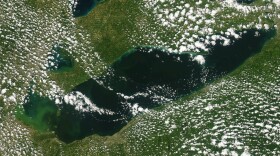The cyanobacterial bloom on Lake Erie has grown 20 miles in the past week. It now covers 620 square miles of Lake Erie, taking up about 6 percent of the entire lake and covering more area than Detroit and its suburbs.
Hugh McDiarmid is with the Michigan Department of Environment, Great Lakes, and Energy. He says summer is the peak time for these blooms.
“The warm water in the heat of summer has a lot to do with it. The amount of nutrients the algae has to feed off of is greater in the summer when there's more activity in the lake. And calm conditions also tend to make the conditions right for the growth of this algae.”
He also points to the abundance of nutrients as one of the primary causes for blooms on Lake Erie. He says the problem has been going on for a very long time.
“Nutrient-loading comes naturally from soils, but also from a lot of the farm runoff, from the agriculture around the lakes. Wastewater treatment facilities can discharge nutrients into the lakes, so there’s a variety of ways that nutrients can get into the lakes and exacerbate the problem.” He says, “We don’t expect this problem to go away in coming years unless some measures are taken to reduce nutrient loading into Lake Erie.”
McDiarmid says regulations to prevent nutrient-loading into Lake Erie passed in the 70s and 80s helped alleviate the appearance of cyanobacterial blooms in the lake, but the blooms have had a resurgence in recent years. He points to the 2014 Toledo water crisis as an example.
There’s no concrete way to predict when these blooms occur, but with plenty of sun and warm temperatures in the forecast for the next week, conditions are ripe for the bloom to continue expanding.
Cyanobacterial blooms have the potential to release toxins that cause harm to humans and animals. McDiarmid says that since there’s no way to identify toxic algae by sight alone, and since it’s still unclear whether this bloom is toxic or not, swimmers and boaters should avoid making contact with the bloom altogether.
“The symptoms of contact with toxic algae are rashes, hives, asthma-like symptoms. If you swallow toxins, you can develop flu-like symptoms, have abdominal pain. In great quantities it could conceivably harm your kidneys and liver.” He says the toxins have also been known to harm dogs, who will go swimming and then often lick their fur. “It can happen pretty quick with the pets, where you see vomiting, fatigue, staggering, convulsions, and in rare instances it has actually killed dogs.”
In Michigan, you can report algal blooms you think might be toxic to EGLE by calling 1 (800) 662-9278 or emailing AlgaeBloom@Michigan.gov.




